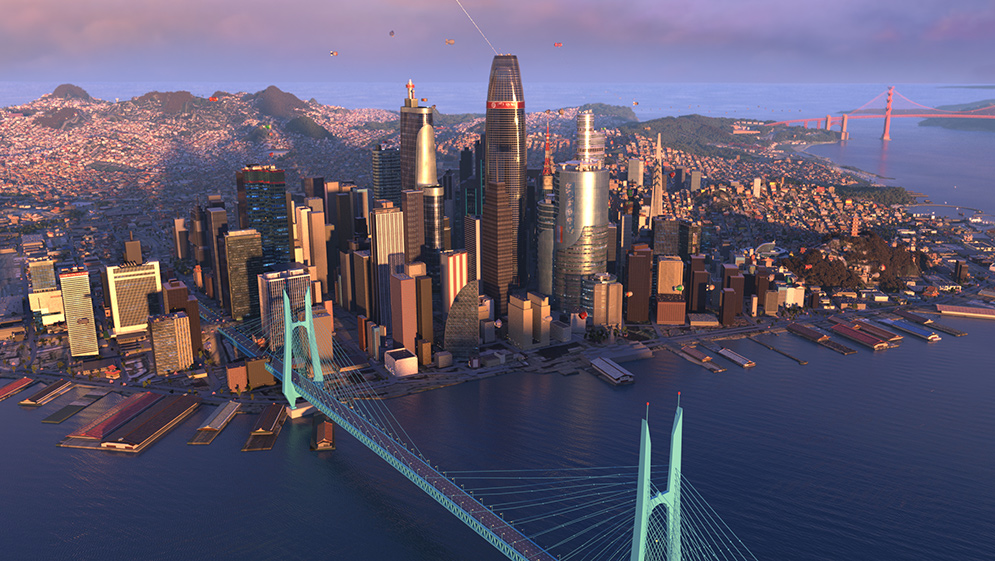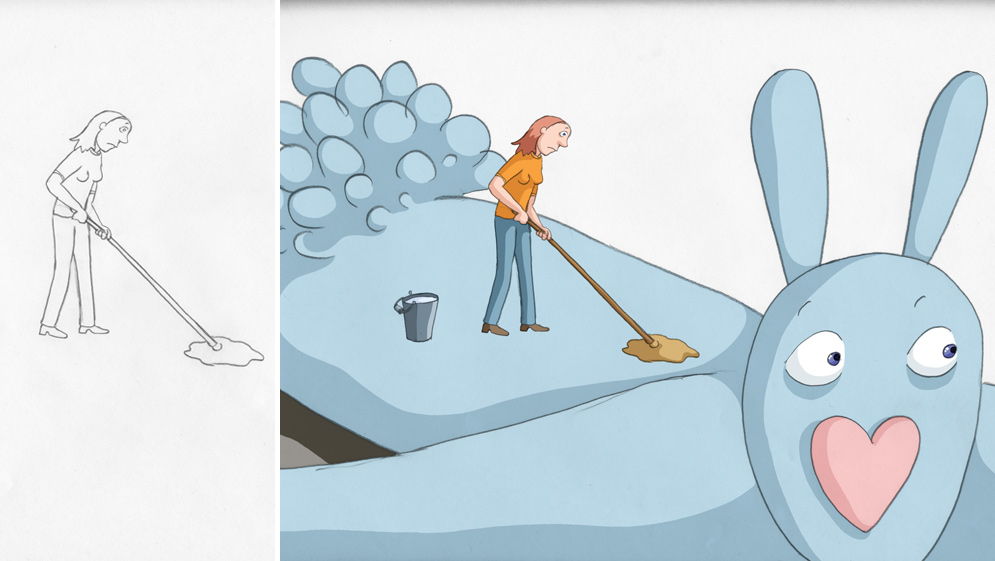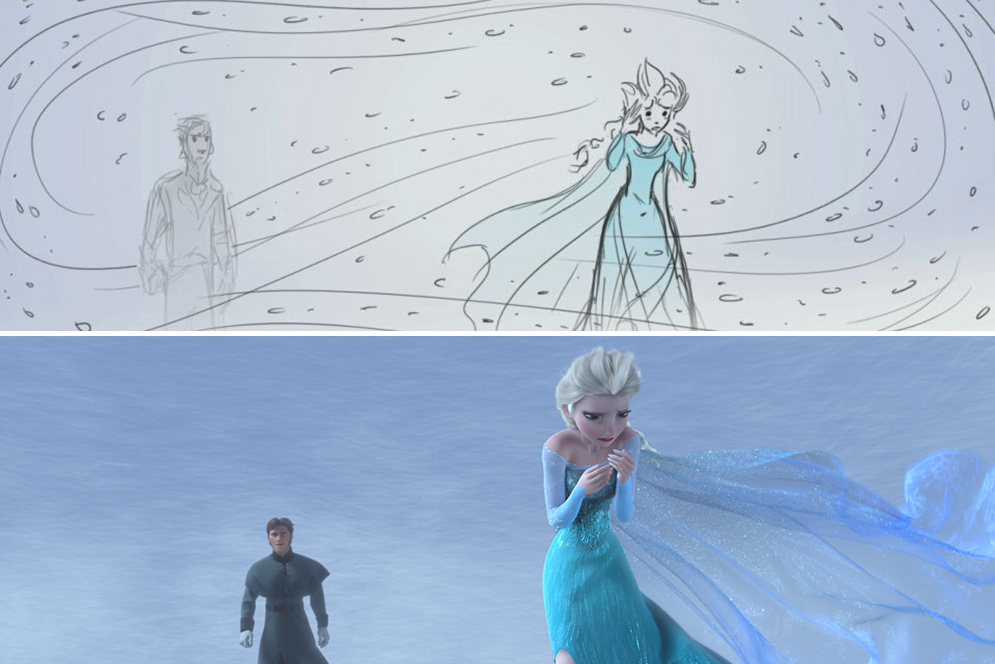From Sketch to Screen
CFA alums stretch the limits of animation and imagination

For Big Hero 6, Disney created San Fransokyo, the largest set piece ever made for an animated feature; it’s populated by hundreds of thousands of citizens. Photo courtesy of Disney
The man on the computer screen, buried to his shoulders in thick, white goo, strains to move. His shadow looms behind him, breaks apart, and melts into the distance as he slogs inexorably to the edge of the frame. It’s an animated image, or GIF (Graphics Interchange Format), and the artist bringing him to life is Wendy Cong Zhao (CFA’11, COM’11), who achieves the illusion of strenuous movement in a series of 34 line drawings. In this and other GIFs she shares on her blog, the classically trained painter is beginning to experiment with animation.
This experimentation has led her to rethink how she creates art and the idea that a single artwork is the end goal. When studying fine art, she says, “we work for a long time on one drawing or painting. Then, we hang it up and take a long time to study it.” In animation, however, the illusion of movement is achieved by connecting tens, hundreds, thousands—hundreds of thousands—of individual drawings. “When they’re all moving together, each drawing is only seen for a split second. Each could be very good, but it’s not about that. On screen, you see the film as a whole.”
The illusion of movement has captivated audiences since the first animated film, J. Stuart Blackton’s Enchanted Drawing (1900), which featured a tuxedoed man coaxing chalkboard drawings to life through stop-motion animation. From the costume to the staging, Blackton presented animation as a magic trick, and in the decades since, even as audiences and films have become more sophisticated, the spell holds.
“Animation is one of the most magical art forms you can imagine,” says Roy Conli (CFA’87), a producer for Walt Disney Animation Studios. And today, CFA alums like Conli and Zhao are the ones making the magic. From granting movement to line drawings to conjuring an entire city on screen, they are stretching the limits of animation and imagination.

For her indie feature film Rocks in My Pockets, animator Signe Baumane developed the story and created storyboards—thumbnail sketches that illustrate the staging for each scene—before she and Wendy Cong Zhao (CFA’11, COM’11) added color, vocals, music, movement, and effects. Courtesy of Wendy Cong Zhao and Signe Baumane
It starts with a story
Animator Signe Baumane had a story to tell. In her 2014 feature film Rocks in My Pockets, she traces her struggle with depression through the generations to her grandmother, who fell in love with a risk-taking entrepreneur prone to jealousy in 1920s Latvia. Baumane plunges into her story of fantasy and madness through stop-motion animation driven by a crisp voice-over.
“The script was the blueprint,” says Zhao, who worked with Baumane as a colorist and then as a compositor and editor from 2011 to 2013. “Signe recorded the voice-over first. We had to cut it up a little bit, but the main structure remained unchanged.” With the story in place, Baumane developed storyboards—thumbnail sketches that illustrate the staging for each scene—and worked with a team of five assistants and interns to animate the piece. Although collaboration was vital to the process, Baumane’s singular vision steered the story and the film’s production.
Collaborative storytelling is central to the process at big studios like Pixar and Disney, where 12 directors each pitch a minimum of three ideas to the Story Trust, a team of the studio’s directors and chief creative officer. When the Story Trust considers which stories to pursue, says member Peter Del Vecho (CFA’80), producer of Disney’s Academy Award–winning film Frozen, “we ask ourselves: What do we want to see next, as moviegoers?”
Once a film is green-lighted, the director, writer, and a team of 8 to 10 story artists spend two to three years developing the story. “Everybody will be in the room throwing out ideas,” says Pixar story artist Christian Roman (CFA’91), who worked on Toy Story 3. “People will have pads of paper and do little gags that may or may not further the story, but will at least be a little funny moment.”
As they sketch from the working script, the story artists consider a variety of questions: “What’s the point of the scene? What do I want the audience to feel about it? How can I make this part of the story better?” says Roman. “A lot of creative freedom is given to the story artists to own their sequence.”
As the story develops, sketches-in-progress are compiled with vocal, music, and effects tracks to create an animatic, or animated storyboard, which is screened every 12 weeks for the studio’s entire team of directors and writers. “We essentially tear it apart,” says Conli, producer of Disney’s Academy Award–winning film Big Hero 6. “Often, 75 percent of it goes back into development, but the 25 percent that stays is going to be the core of the story you tell.”
Del Vecho points to the last scene of Frozen as an example of the efficacy of this process.

A Disney artist placed Frozen’s ending scene on a fjord and manifested Queen Elsa’s emotions as a storm. The clarity of the staging “gave us the impact of the scene we had hoped for,” says film producer Peter Del Vecho (CFA’80). John Ripa, Walt Disney Feature Animation (top); courtesy of Walt Disney Feature Animation (bottom)
Loosely based on Hans Christian Andersen’s fairy tale The Snow Queen, Frozen is the story of Princess Anna’s epic quest to save her sister, Queen Elsa, who has suspended their kingdom in winter.
When Anna falls under a spell that begins to freeze her heart, only an act of true love can save her. “We always knew we wanted to end the movie with the true love being between the sisters, but it wasn’t very clear how to stage the ending to achieve the desired emotional impact,” Del Vecho says. The team finally agreed on an ending, but one artist had a different idea.
“He went off for two weeks and sketched up a new ending and pitched it to us,” Del Vecho says. To achieve the compelling climax, the artist “first placed the scene out on the fjord, and second, had Elsa’s emotions manifest as a storm that makes it believable that everyone is close to each other, but cannot see each other until the right moment, when the storm suspends—easy in hindsight. It was the clarity of the staging that gave us the impact of the scene we had hoped for. We gave the artist a standing ovation.”
Building character
In tandem with developing a story through script work and sketching, the creative team collaborates to produce memorable characters, like Elsa from Frozen, Woody from Toy Story—and the puffy white robot Baymax, who steals every scene in the Disney film Big Hero 6. An inflatable health care robot, Baymax is the brainchild of Tadashi, who dies in an accident, leaving a grief-stricken little brother, Hiro. Hiro stumbles across Baymax among his brother’s belongings, and the robot sees the boy’s grief as a wound he must heal.
When developing Baymax, directors Don Hall and Chris Williams were aiming to create an original, a robot different from anything the audience would have seen before. They filled their story room with pictures of “literally every robot that has ever been in a film,” says Conli. WALL-E, Robby the Robot, Gort from The Day the Earth Stood Still—“the room was just plastered.”
“We want to make sure we are dealing with themes and characters that resonate with audiences worldwide, and that means getting to the core fundamental values we all share.”—Peter Del Vecho
Hall and Williams visited the Robotics Institute at Carnegie Mellon University. There they met researchers working in the field of soft robotics to develop a health care robot made of inflated vinyl that would tend gently to elderly patients. This project “sparked in Don’s mind the idea of a huggable robot,” Conli says. “This was the beginning of Baymax, and the fact that he was a health care robot made total sense within the structure of our story.”
When the team had Baymax’s shape, they drew out his personality through expressions and movement. “Animators are essentially actors with computers—we used to say ‘actors with pencils,’” Conli says. “They do a lot of research, as an actor does, exploring character.” Influenced by Japanese animation, the creative team traveled to Japan, where they stumbled upon a suzu bell at a Shinto shrine. It seemed to be smiling serenely at them, Conli says, and inspired Baymax’s simple yet expressive features.
Finally, “we recognized that we were going to want a super-appealing walk,” he says. The team watched videos to find the cutest walks in nature, which they determined were “a human baby in a diaper, a human baby in a loaded diaper, and a baby penguin. The baby penguin won.” They had found Baymax’s distinctive waddle.
Lights, camera, action
Once the story works and the characters are waiting in the wings, it’s time to bring the film to life. The storyboard artists sketch each scene, complete with movement, lighting, and camera angles. “Every little detail should support the direction of the story you want to tell,” Roman says. The storyboards then head to a production team that animates the story.
At Pixar, it’s about a two-year process—beyond the two or three years it takes to develop a story. Modelers create the characters and backgrounds on the computer, then riggers add points of articulation to the models so they can be manipulated. The layout artists use the storyboards to develop rough blocking, placing the camera within the scenes and the characters in their key poses. The animators enrich the posing, camera movements, and character expressions, which are all coordinated with the actors’ voice recordings. The lighting team then adds shading, textures, and reflections to the scenes.
“Every step has people who are experts,” Roman says. “We all work together. It is always an amazing bit of alchemy when everybody is firing on all cylinders.” All told, the process of bringing a single film like Toy Story 3, Frozen, and Big Hero 6 to the screen involves the work of anywhere from 350 to 800 people.
Story artist Christian Roman (CFA’91) gives us a behind-the-scenes look at the Pixar animation process. Video by Taylor Toole
Although a small production like Rocks in My Pockets follows a similar process, Baumane did not have the budget for a big team. She drew characters on paper by hand and constructed backgrounds from papier-mâché, painted wooden boards, and other materials. To achieve the illusion that the 2-D characters are moving through the 3-D sets, she created numerous drawings for each movement, all of which were colored, shaded, textured, and lit. In all, the film required 30,000 drawings.
Zhao worked with Baumane to bring the characters and their world together; she edited the scenes, digitally colored each one in Photoshop, composited them in Adobe After Effects, and edited the film.
She had to not only develop new technical skills, but employ the traditional skills she learned at CFA. “It helped to have taken sculpture classes,” she says, “to know what it should look like when a character moves through space, especially if the background is moving, like if there’s a pan or a zoom.” And the skills she developed as a painter enabled her to shade characters with the knowledge of how different light sources generate shadows.
“The ability to draw well, compose, understand perspective and color theory, and so on, is key to working and creating animation,” Roman says. “The computer doesn’t compensate for a lack of creativity or artistic ability. It is simply a tool, like a brush or a pencil.”
“Every once in awhile, you get to work on a film that takes on a life of its own,” Del Vecho says of the film that has inspired Halloween costumes, stuffed animals, jewelry, toys, stamps, sheets—and more than 55 million YouTube videos of fans singing “Let It Go.”
He saw firsthand the continuing enchantment with Frozen during BU’s 2014 Alumni Weekend, when he took alums behind the scenes of the film. As he screened a clip, four little girls sitting at the back of the auditorium shot to their feet to sing along to “For the First Time in Forever.” After the talk, Del Vecho opened the floor to questions, and he called on one of the movie’s littlest fans first. She asked, “How does Elsa make snow come out of her hand?”
The producer expounded upon the animation techniques behind the character’s dramatic talent, which Elsa perceives as a curse, and how her struggle to control the power ties into the film’s theme: love, not fear.
This wasn’t the answer the young girl was looking for. At the end of Del Vecho’s explanation, she asked, “But how does she do it?” How does Elsa actually make magic?
The spell holds.
Lara Ehrlich can be reached at lehrlich@bu.edu.
A version of this story was originally published in the fall 2015 issue of Esprit.
Comments & Discussion
Boston University moderates comments to facilitate an informed, substantive, civil conversation. Abusive, profane, self-promotional, misleading, incoherent or off-topic comments will be rejected. Moderators are staffed during regular business hours (EST) and can only accept comments written in English. Statistics or facts must include a citation or a link to the citation.